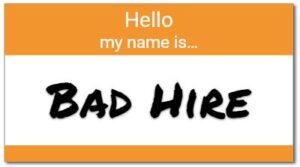Imagine this. You hire someone new for your team at work. You are super excited about this new hire and you invest a lot of  your time and energy into him. A few months later, you get the gut feeling that you have made a terrible mistake – you hired the wrong person. What do you do?
your time and energy into him. A few months later, you get the gut feeling that you have made a terrible mistake – you hired the wrong person. What do you do?
For so many companies, it is easy to fall into the trap of just going through the motions, keep working with this person, fingers crossed that will eventually work out. Unfortunately, just crossing your fingers and hoping for the best is being “reactive” not “proactive”, and it’s going to cost you tons of money, time, and your company’s culture.
Performance Shift:
I recommend that my clients set up a 100-Day Plan and Assessment period for their new hires. This 100-day probationary period provides the employer time to evaluate their new employee to make sure that he or she fits with the company and has learned the job properly over the time allotted. This shift in behavior is the best of both worlds for both parties – not only does it offer you an opportunity to evaluate your new hire, he/she also has time to make sure you and your company are a good fit for him/her.
- At the start of the hire, work with the new person to come up with the Plan – how would you know if he/she is a good fit after 100 days? What metrics need to be accomplished at a minimum? What would be a win after 100 days? A fail?
- This plan is also a huge asset for onboarding because it directly guides what needs to be worked on for the first 100 days. The development of the Plan is also a great exercise for you to see how the new hire strategically plans, organizes, and comes up with goals. After the 100 days have passed, you sit down with the new hire and talk about whether the position is a fit for both parties.
- Consider paying the wrong hires to leave. Keep reading below.
Tony Hsieh, the late former CEO of Zappos, pioneered the concept of paying new, unhappy employees $2,000 to quit in order to maintain a happy, productive workforce. He would rather spend money and get the “wrong” people out of his company than risk his company’s culture. It was a bold move that had huge results. He called it “The Offer,” a program that offered new employees who decided they were unhappy a $2,000 bonus to quit following a four-week training period. The practice was designed to weed out those who wouldn’t be as committed to and passionate about their work, thereby bolstering overall happiness in the company’s workforce.
Your new hires are people, not apples at the farmers market. You don’t get to buy them and then throw half of them out the minute you get home because they have a little spot on them. I know you have big plans for what you want this new hire to do and achieve for your team and the company. However, they are still NEW (even though they are experienced). The biggest mistake you can make is expecting them to run when they are just learning how to walk. This is why the 100-Day Plan is so good.
This will give you the altitude and empathy to be the manager that your employees deserve and your company’s customers need.
Red Adair, an American oil firefighter once said, “If you think it’s expensive to hire a professional to do the job, wait until you hire an amateur.”
If you want to learn more about interview techniques, reach out to Chris!
Follow Chris on social media and don’t forget to come back next week for Part 3 of this 3 Part Blog Series: Let the Wrong People Pass By You! Find the Givers and Pass on the Takers.
Co-authored by: Betsy Moore, Industrial/Organizational Psychology Consultant & Health Coach













